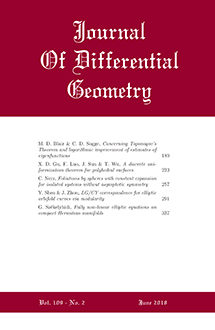Abstract
The Teichmüller harmonic map flow deforms both a map from an oriented closed surface $M$ into an arbitrary closed Riemannian manifold, and a constant curvature metric on $M$, so as to reduce the energy of the map as quickly as possible [16]. The flow then tries to converge to a branched minimal immersion when it can [16, 18]. The only thing that can stop the flow is a finite-time degeneration of the metric on $M$ where one or more collars are pinched. In this paper we show that finite-time degeneration cannot happen in the case that the target has nonpositive sectional curvature, and indeed more generally in the case that the target supports no bubbles. In particular, when combined with [16, 18, 9], this shows that the flow will decompose an arbitrary such map into a collection of branched minimal immersions.
Citation
Melanie Rupflin. Peter M. Topping. "Teichmüller harmonic map flow into nonpositively curved targets." J. Differential Geom. 108 (1) 135 - 184, 2018. https://doi.org/10.4310/jdg/1513998032





